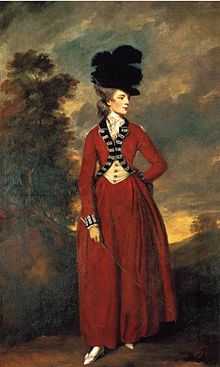Seymour Dorothy Fleming

Seymour Dorothy Fleming (1758 – 9 September 1818) was an 18th-century British noblewoman, notable for her involvement in a separation scandal. She was the younger sister of Jane Stanhope, Countess of Harrington, who was noted for being a "paragon of virtue".
Life
She was the younger daughter and coheir of the Irish-born Sir John Fleming, 1st Baronet (d. 1763), of Brompton Park, Middlesex, and his wife, Lady (Jane) Coleman (d. 1811). Her father and two of her sisters died when she was 5 and she and her elder sister, Jane, were then raised by her mother. Her mother remarried in 1770 to a rich sexagenarian born in Barbados, Edwin Lascelles, 1st Baron Harewood.
At the age of 17, Seymour Fleming married Sir Richard Worsley, 7th Baronet of Appuldurcombe House, Isle of Wight, on the 20 September 1775, and assumed the title of Lady Worsley until his death. She was rumoured to have been worth £70,000 upon her marriage, but in truth only brought £52,000 to the union. The couple had one legitimate child, a son, Robert Edwin who died young. Lady Worsley bore a second child, Jane Seymour Worsley in August 1781, fathered by Maurice George Bisset but whom Sir Richard claimed as his own to avoid scandal.
Badly suited to one another, the couple's marriage began to fall apart shortly after marriage. Lady Worsley was rumoured to have had 27 lovers and in February 1782, Sir Richard brought a criminal conversation case for £20,000 against one of them. In November 1781, Lady Worsley ran off with a captain in the South Hampshire militia by the name of George M Bissett. Bisset had also been Sir Richard's closest friend and neighbour at Knighton Gorges on the Isle of Wight. Although Sir Richard looked to have a strong case against Bisset it was undone by the shocking revelations of the criminal conversation trial, which included testimony by a number of Lady Worsley's lovers and her doctor, William Osborn, who related that she had suffered from a venereal disease which she had contracted from the Marquess of Graham. It was later proven that Sir Richard had displayed his wife naked to George Bisset at the Bath house in Maidstone. This evidence destroyed Sir Richard's suit and the jury awarded him only 1 shilling in damages.
Eventually, George Bisset left Lady Worsley when it became clear that Sir Richard was seeking separation rather than divorce (meaning Seymour could not re-marry until Richard's death). Seymour was forced to become a professional mistress or demimondaine and live off the donations of rich men in order to survive, joining other upper-class women in a similar position in The New Female Coterie.[1] She had two more children; another by Bisset after he left her in 1783 whose fate is unknown, and a fourth, Charlotte Dorothy Hammond (née Cochard) who she sent to be raised by a family in Belgium. Lady Worsley was later forced to leave for Paris in order to avoid her debts.
In 1788 she and her new lover the Chevalier de Saint-Georges returned to England and her estranged husband entered into articles of separation, on the condition she spend 4 years in exile in France. She was trapped in France 8 months before the expiration this exile by the events of the French Revolution and so she was probably imprisoned during the Reign of Terror, meaning she was abroad on the death of her and Sir Richard's son in 1793. Early 1797 saw her quietly return to England, and she then suffered a severe 2-month illness. Due to the forgiveness of her mother, her sister and her sister's husband, the Earl of Harrington, she was then able to move into Brompton Park, the home that was hers but which the laws on property ownership prevented her from officially holding.
On Sir Richard's death in 1805 her £70,000 jointure reverted to her and just over a month later, on 12 September, she married John Lewis Cuchet at Farnham. Also that month, by royal licence, she officially resumed her maiden name of Fleming, and her new husband also took it. After the armistice of 1814 ended the War of the Sixth Coalition the couple moved to a villa at Passy, where she later died in 1818.
Bibliography
- Rubenhold, Hallie (2008). Lady Worsley's Whim. London: Vintage Books.
References
- ↑ Rubenhold (2008) pp.171-183
External links
- "Worsley, Sir Richard". Oxford Dictionary of National Biography (online ed.). Oxford University Press. doi:10.1093/ref:odnb/29986. (Subscription or UK public library membership required.), with information on his wife
- http://www.british-history.ac.uk/report.aspx?compid=47510
- http://holmesacourt.org/d3/i0001304.htm
- http://www.nationalarchives.gov.uk/catalogue/displaycataloguedetails.asp?CATLN=7&CATID=-4310065&FullDetails=True&j=1&Gsm=2008-08-08
- (French) www.odoc.com
|